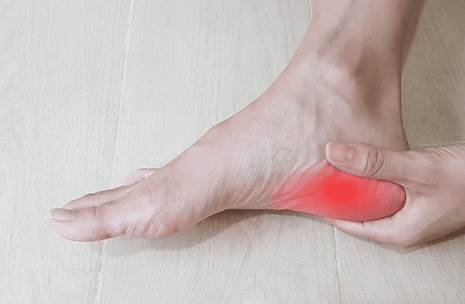
Plantar Fasciitis
Plantar fasciitis is the inflammation of a thick band of the plantar fascia, a thick band of tissue that connects the heel bone to the toes. Plantar fasciitis is the result of collagen degeneration of the plantar fascia at the origin, the calcaneal tuberosity of the heel as well as the surrounding perifascial structures. Plantar heel pain is the most commonly seen foot pain condition treated by health care workers.
The pathology is characterised by insidious-onset sharp pain in the medial heel, from the medial plantar fascia border to insertion at the calcaneal medial tuberosity,which worsens with weight-bearing and after periods of rest or non-weight-bearing. Plantar fasciitis frequently presents as a chronic condition, with symptoms often persisting for more than a year.
Approximately 50% of patients with this condition also have heel spurs, although the spurs are not the cause of the condition. Plantar fasciitis is commonly associated with runners and older adults, but other risk factors include obesity, heel pad atrophy, ageing, and occupations requiring prolonged standing and weight-bearing.
Causes :
Main cause is over straining of the Plantar Fascia, straining may occur in different ways and finally lead to inflammation, pain, swelling, etc.
- Flat foot
- Calcaneal spur
- Over straining like long walk, running, ballet dance, aerobic dance, etc.
- Especially on hard surfaces
- Improper shoes
- High heeled footwear
- Overweight
- Weak calf muscles
- Tight muscles in the foot and leg, high impact activities
- Diabetes Mellitus (and/or other metabolic condition)
- Tightness and/or weakness of gastrocnemius-soleus complex, Achilles tendon, and intrinsic muscles of the foot
Plantar fasciitis is most commonly seen in runners causing causing micro-tears of the plantar fascia. Basically, repetitive motion or anything that puts a lot of pressure on the arch of your foot might cause it.
Symptoms :
- Stabbing pain near the heels
- Tenderness to the anterior medial heel
- Pain is most severe during the first few steps in the morning
- Pain gets worse after prolonged standing or rising from sitting, after exercise
- Pain during activities like running, walking, or lifting heavy weights
- Limited dorsiflexion and tight Achilles tendon
- A limp may be present or may have a preference to toe walking
- Pain is usually worse when barefoot on hard surfaces and with stair climbing
Ayurvedic Perspective Of Heel Pain :
In Ayurveda, this condition is referred to as Vatakandaka, resulting from the vitiation of Vata is responsible for movement and circulation in the body,which governs body and mind movements, along with other doshas and dhatus. This vitiation causes a sharp, stinging pain in the heel of the foot.
When vata dosha disturbs pitta dosha, it leads to inflammation, burning sensation, redness and pricking pain.
Treatment :
- The goal of Ayurvedic treatment is to treat the root cause of pain and inflammation that is triggering plantar fasciitis symptoms and to normalise three dosha (bio energies) and to nourish the vitiated dhatus (tissues), also to reduce the pain and inflammation.
- Ayurveda treatment helps to reduce pain and inflammation in the short term with the help of anti-inflammatory and pain relieving herbs and medicines.
- Additionally, Ayurvedic therapies, balanced nutrition, stretching exercises and yoga help to detoxify, reduce inflammation in the body and strengthen the muscles in the foot, thus preventing future occurrence.
- Rest and cold therapy with ice (in case of burning sensation) are often recommended for the first few days after the pain begins. Stretching exercises and yoga are also helpful in treating Plantar Fasciitis.
Treatment Methods :
Abhyanga – Oil Massage : A traditional Ayurvedic technique involving warm herbal oil massages on the heels. It improves circulation, reduces stiffness, and eases pain, tailored to the individual’s dosha.
1. Swedana – Heat Therapy: Heat therapy is applied to the heels, often using heated bricks (Ishtika Sweda). This reduces inflammation, enhances blood flow, and provides pain relief.
2. Avagaha – Foot Soaking: Soaking the feet in warm herbal oils chosen for their anti-inflammatory properties. This method effectively alleviates heel pain and discomfort.
3. Dhara – Medicated Oil Dripping: A unique procedure where medicated oils are gently poured over the heels. This reduces inflammation and pain, promoting relief.
4. Poultice and Bandaging: Herbal mixtures are applied directly to the skin and covered with a bandage. This method reduces pain and inflammation, often using ingredients like ginger and turmeric.
5. Agni Karma – Controlled Cauterization: Controlled cauterization of specific points on the heel with heat application. It stimulates blood circulation and aids healing when administered by qualified practitioners.
6. Panchakarma Procedures: Panchakarma detoxification therapies balance doshas and include:
- Virechana (Purgation): Eliminates vitiated pitta and vata doshas, nourishing bone tissue. It is particularly useful in treating conditions like Plantar Fasciitis where there is accumulation of toxins in the tissues.
- Basti (Medicated Enema): Uses herbal oils or medicated milk to heal pain and inflammation.
- Rakta Mokshana (Blood Letting): Controlled bloodletting to relieve pain and inflammation.
These treatments help to improve circulation, reduce inflammation and pain, and promote healing in the body.

